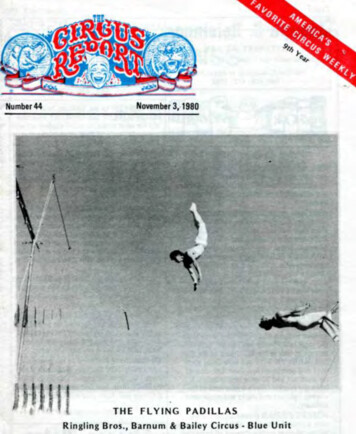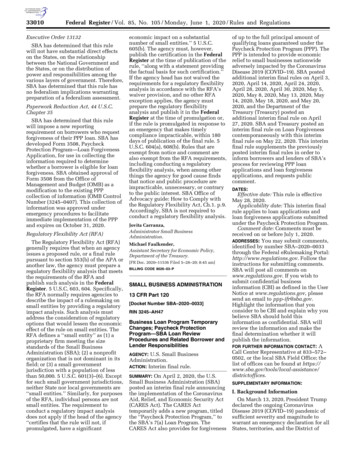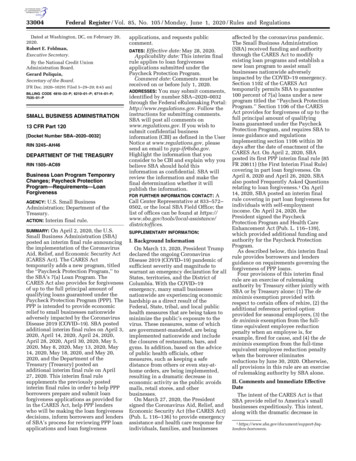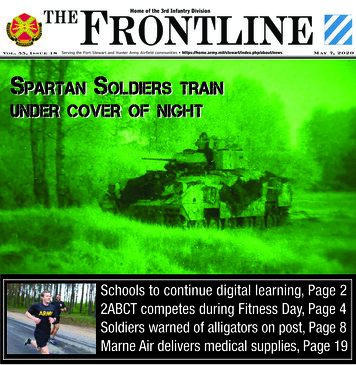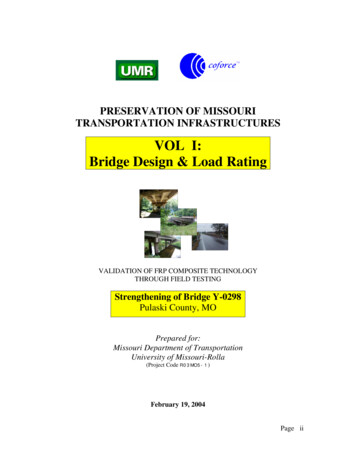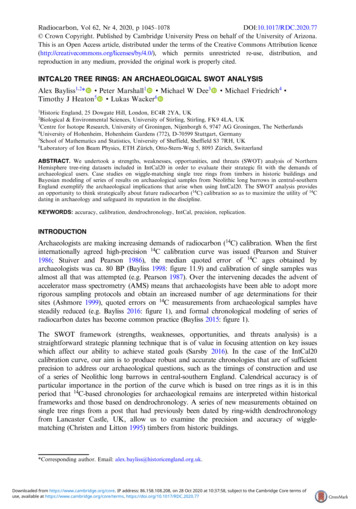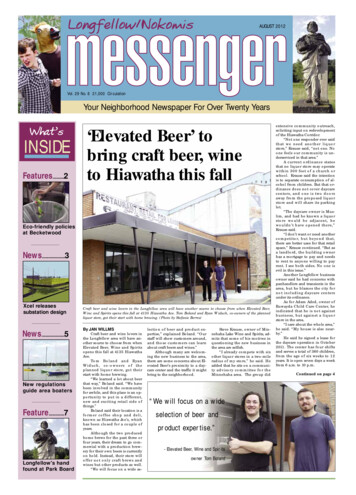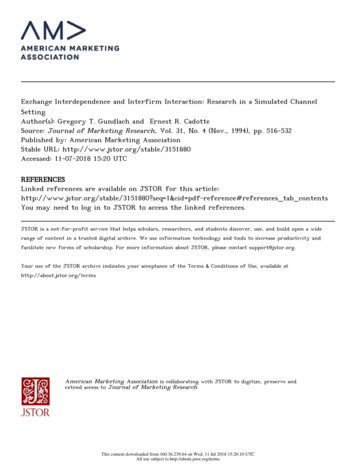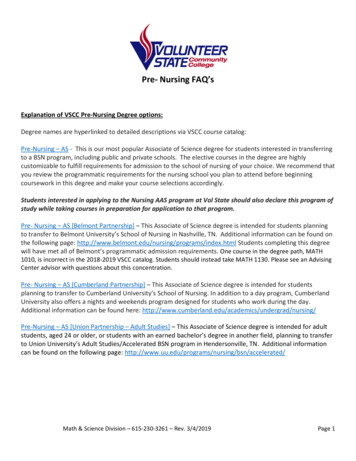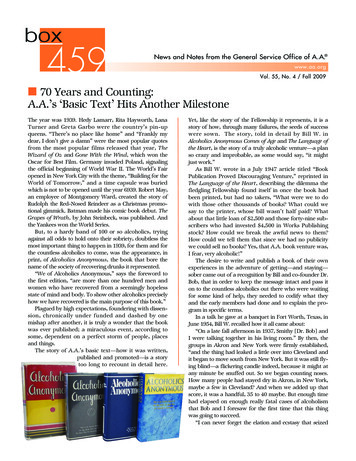
Transcription
News and Notes from the General Service Office of A.A. www.aa.orgVol. 55, No. 4 / Fall 2009 70 Years and Counting:A.A.’s ‘Basic Text’ Hits Another MilestoneThe year was 1939. Hedy Lamarr, Rita Hayworth, LanaTurner and Greta Garbo were the country’s pin-upqueens. “There’s no place like home” and “Frankly mydear, I don’t give a damn” were the most popular quotesfrom the most popular films released that year, TheWizard of Oz and Gone With the Wind, which won theOscar for Best Film. Germany invaded Poland, signalingthe official beginning of World War II. The World’s Fairopened in New York City with the theme, “Building for theWorld of Tomorrow,” and a time capsule was buriedwhich is not to be opened until the year 6939. Robert May,an employee of Montgomery Ward, created the story ofRudolph the Red-Nosed Reindeer as a Christmas promotional gimmick. Batman made his comic book debut. TheGrapes of Wrath, by John Steinbeck, was published. Andthe Yankees won the World Series.But, to a hardy band of 100 or so alcoholics, tryingagainst all odds to hold onto their sobriety, doubtless themost important thing to happen in 1939, for them and forthe countless alcoholics to come, was the appearance, inprint, of Alcoholics Anonymous, the book that bore thename of the society of recovering drunks it represented.“We of Alcoholics Anonymous,” says the foreword tothe first edition, “are more than one hundred men andwomen who have recovered from a seemingly hopelessstate of mind and body. To show other alcoholics preciselyhow we have recovered is the main purpose of this book.”Plagued by high expectations, foundering with dissension, chronically under funded and dashed by onemishap after another, it is truly a wonder that the bookwas ever published; a miraculous event, according tosome, dependent on a perfect storm of people, placesand things.The story of A.A.’s basic text—how it was written,published and promoted—is a storytoo long to recount in detail here.Yet, like the story of the Fellowship it represents, it is astory of how, through many failures, the seeds of successwere sown. The story, told in detail by Bill W. inAlcoholics Anonymous Comes of Age and The Language ofthe Heart, is the story of a truly alcoholic venture—a planso crazy and improbable, as some would say, “it mightjust work.”As Bill W. wrote in a July 1947 article titled “BookPublication Proved Discouraging Venture,” reprinted inThe Language of the Heart, describing the dilemma thefledgling Fellowship found itself in once the book hadbeen printed, but had no takers, “What were we to dowith those other thousands of books? What could wesay to the printer, whose bill wasn’t half paid? Whatabout that little loan of 2,500 and those forty-nine subscribers who had invested 4,500 in Works Publishingstock? How could we break the awful news to them?How could we tell them that since we had no publicitywe could sell no books? Yes, that A.A. book venture was,I fear, very alcoholic!”The desire to write and publish a book of their ownexperiences in the adventure of getting—and staying—sober came out of a recognition by Bill and co-founder Dr.Bob, that in order to keep the message intact and pass iton to the countless alcoholics out there who were waitingfor some kind of help, they needed to codify what theyand the early members had done and to explain the program in specific terms.In a talk he gave at a banquet in Fort Worth, Texas, inJune 1954, Bill W. recalled how it all came about:“On a late fall afternoon in 1937, Smithy [Dr. Bob] andI were talking together in his living room.” By then, thegroups in Akron and New York were firmly established,“and the thing had leaked a little over into Cleveland andit began to move south from New York. But it was still flying blind—a flickering candle indeed, because it might atany minute be snuffed out. So we began counting noses.How many people had stayed dry in Akron, in New York,maybe a few in Cleveland? And when we added up thatscore, it was a handful, 35 to 40 maybe. But enough timehad elapsed on enough really fatal cases of alcoholismthat Bob and I foresaw for the first time that this thingwas going to succeed.“I can never forget the elation and ecstasy that seized
Box 4-5-9 is published quarterly by the General ServiceOffice of Alcoholics Anonymous, 475 Riverside Drive,New York, NY 10115, Alcoholics Anonymous WorldServices, Inc., 2009Mail address: P.O. Box 459, Grand Central StationNew York, NY 10163G.S.O.’s A.A. Web Site: www.aa.orgSubscriptions: Individual, 3.50 per year; group, 6.00 foreach unit of 10 per year. Check—made payable to A.A.W.S.,Inc.—should accompany order.us both. It had taken three years to sober up the handful,and there had been an immense amount of failure. Howcould this handful carry its message to all those who stilldidn’t know? Not all the drunks in the world could cometo Akron or to New York. How could we transmit ourmessage to them?” The two began mulling over the possibilities. Bill, always the entrepreneur, had big ideas. Hewanted to create a chain of hospitals to sober up thousands of drunks and to send out missionaries to spreadthe word.“And, we reflected, we’d have to get some kind of literature. Up to this moment, not a syllable of this programwas in writing. It was a kind of word-of-mouth deal, withvariations according to each man’s or woman’s understanding .“How could we unify this thing? Could we, out of ourexperience, describe certain methods that had done thetrick for us? Obviously, if this movement was to propagate, it had to have literature so its message would not begarbled, either by the drunk or by the general public.”The first step in this plan was, of course, to actuallywrite the book. Yet, in prime alcoholic fashion, Bill got thecart before the horse and set into motion a series of intricate promotional plans to raise money to finance the vastrecovery empire he envisioned. Once financing had beensecured, the book would be published, and they would allsit back with the “money rolling in.”“These reflections led us straight into a typical alcoholicfantasy!” wrote Bill in 1947. “Why not publish the bookourselves? Though told by almost everybody who knewanything of publishing that amateurs seldom producedanything but flops, we were not dismayed. This time, wesaid, it would be different.”After convincing a number of the early members to buystock certificates in the “hastily organized” WorksPublishing Company—the company formed to receive theuntold millions Bill and his friend Henry P., another alcoholic promoter, expected would roll in—confidence washigh. “Not only were we selling common stock on a book2to cure drunks—the book itself hadn’t yet been written.Amazingly enough, we did sell that stock, 4,500 worth,to alcoholics in New York, New Jersey, and to theirfriends. No one of the original 49 subscribers put up over 300. Almost everybody paid on monthly installment,being too broke to do otherwise .”In May 1938, when Bill finally began work on the firstdraft, he had been sober about three and a half years.Dr. Bob was sober a few months less than three years,and the other 100 early members who contributed in oneway or another to the writing of the book had beensober for periods ranging from a couple of years to acouple of months.They were a contentious, cantankerous bunch of newlydry drunks, clinging together desperately to preserve theirhard-won sobriety, and still figuring it out by a process oftrial and error. Yet, this shaky, often fearful group of menand women somehow brought to publication, in April1939, a book that provided a blueprint for recovery fromalcoholism that has been followed successfully for seventyyears by millions of sober alcoholics in over 180 countriesaround the world.How did they manage to set forth a clear description oftheir experience that would stand the test of time? Bill tellsthe story in Alcoholics Anonymous Comes of Age. Earlyon, he had written a few chapters of a possible book touse in raising money, and after Reader’s Digest expressedinterest in an article on A.A. and its (as yet unwritten)book—interest, by the way, that would ultimately nevercome to fruition—Bill set out to complete the manuscript.“Each morning I traveled all the way from Brooklyn toNewark where, pacing up and down in Henry’s office, Ibegan to dictate rough drafts of the chapters of the coming book.”Throughout, he consulted the group conscience, reading each chapter as it was finished to the New York groupat its weekly meeting and sending copies to Dr. Bob toshare with the Akron group. From Akron, he reportedreceiving good support, but the chapters “got a real mauling” from the New York bunch. “I redictated them andRuth [Hock, Henry P.’s nonalcoholic secretary] retypedthem over and over.” In spite of all this, the first few chapters went easily, until he got to Chapter 5, when the alcoholics realized that “at this point we would have to tellhow our program for recovery from alcoholism reallyworked. The backbone of the book would have to be fitted in right here.“This problem had secretly worried the life out of me,”wrote Bill. “I had never written anything before and neither had any other member of the New York group .The hassling over the four chapters already finished hadreally been terrific. I was exhausted. On many a day I feltlike throwing the book out the window.“I was in this anything-but-spiritual mood on thenight when the Twelve Steps of Alcoholics Anonymouswere written. I was sore and tired clear through. I lay inBox 4-5-9, Fall 2009
bed with pencil in hand and with a tablet of scratchpaper on my knee. I could not get my mind on the job,much less put my heart into it. But here was one of thosethings that had to be done. Slowly my mind came intosome kind of focus.”Up to that time, the A.A. program had been strictlyword of mouth, using basic ideas evolved from the OxfordGroups, William James, and Dr. Silkworth, “the little doctor who loved drunks.” It came down, essentially, to sixsteps: admitting powerlessness over alcohol, taking amoral inventory, sharing shortcomings with another person, making restitution, helping other alcoholics, andpraying to God for power to practice these ideas. Therewere considerable variations on this general procedure,however, and at that point, nothing in writing.“As my mind ran over these developments, it seemedto me that the program was still not definite enough. Itmight be a long time before readers of the book in distantplaces and lands could be personally contacted.Therefore our literature would have to be as clear andcomprehensive as possible. Our steps would have to bemore explicit .“Finally I started to write. I set out to draft more thansix steps; how many more I did not know. I relaxed andasked for guidance. With a speed that was astonishing,considering my jangling emotions, I completed the firstdraft. It took perhaps half an hour. The words kept righton coming. When I reached a stopping point, I numberedthe new steps. They added up to twelve. Somehow thisnumber seemed significant.”Then began the grueling process of refining and calibrating these twelve new steps to the point where theywould pass muster with the rest of the alcoholics Bill hadbrought into the process, those in Akron and New York.On the whole, the Akronites liked the new steps and supported the remainder of the text based on them. “But inNew York the hot debate about the Twelve Steps and thebook’s contents was doubled and redoubled. There wereconservative, liberal, and radical viewpoints.”Bill, as the writer, was “caught squarely in the middleof all this arguing . For a while it looked as if we wouldbog down into permanent disagreement .”Yet, just before the manuscript was finished, “an eventof great significance took place . We were still arguingabout the Twelve Steps. All this time I had refused to change a word of the original draft, in which I had consistently used the word ‘God,’ and in one place the expression ‘on our knees’ was used. Praying to God on one’sknees was still a big affront to [several of the alcoholics] we finally began to talk about the possibility of compromise. Who first suggested the actual compromise words Ido not know, but they are words well known throughoutthe length and breadth of A.A. today: In Step Two wedecided to describe God as a ‘Power greater than ourselves.’ In Steps Three and Eleven we inserted the words‘God as we understood Him.’ From Step Seven we deletedBox 4-5-9, Fall 2009the expression ‘on our knees.’ And, as a lead-in sentenceto all the steps we wrote these words: ‘Here are the stepswe took which are suggested as a program of recovery.’A.A.’s Twelve Steps were to be suggestions only .“God was certainly there in our Steps, but He was nowexpressed in terms that anybody—anybody at all—couldaccept and try. Countless A.A.s have since testified thatwithout this great evidence of liberality they could neverhave set foot on any path of spiritual progress or evenapproached us in the first place. It was another one ofthose providential ten-strikes.”Concluding his description of the book-writing process inAlcoholics Anonymous Comes of Age, Bill made it clear thatall the hassles had been worth it. “It should here be emphasized that the creation of A.A.’s book brought forth muchmore than disputes about its contents. As the volume grewso did the conviction that we were on the right track. Wesaw tremendous vistas of what this book might become andmight do. High expectation based on a confident faith wasthe steady and sustaining overtone of feeling that finally prevailed among us. Like the sound of a receding thunderstorm, the din of our earlier battles was now only a rumble.The air cleared and the sky was bright. We all felt good.”Sometime in 2009, in its fourth edition and 70th year ofcontinuous publication, it is expected that the 30 millionthcopy of Alcoholics Anonymous will be sold. Available in 58languages, including American Sign Language and Braille,multiple print and audio formats, A.A.’s basic text hascarried the message of hope and recovery literally aroundthe world.Quite a record of success for a book whose seeds weresown of failure. Central Office/Intergroup SeminarRochester, New York, will be the site of the 24th AnnualCentral Office/Intergroup Seminar, October 2-4, 2009.Hosted by the Rochester Area Intergroup, the event will beheld at the Rochester Plaza & Conference Center. Thisyear’s theme is “Our Commitment to Carry A.A.’sMessage—Enthusiasm & Gratitude in Action.” This annual Seminar provides a forum, through workshops, discussions, and the exchange of ideas and shared experience,for those who are on A.A.’s front line.Attendees are Intergroup/Central Office managers,Intergroup representatives and representatives from theG.S.O. staff, and the A.A.W.S. and Grapevine Boards.Please make your hotel reservations, at special seminarrate, by August 30, by calling 1-866-826-2831, with the 3digit code RAI.Registration fee is 25.00. For a Seminar registration/questionnaire, or other information, contact Kay D.,office administrator, (585) 232-6720; raacog@frontier.net.3
In MemoriamTwo former staff members at the General Service Officerecently passed away, leaving behind a rich legacy of service and a whole host of friends. Spanning multipledecades from the 1950s through the year 2000, both Lib S.and Lois F. were dedicated and trusted servants of theFellowship, offering support and guidance to countlessA.A. members and groups around the world. Lib passedaway on March 19, 2009, at the age of 96, with 63 years ofsobriety, and Lois died on May 11, 2009, at the age of 72,with 36 years of sobriety.Collectively, in their many years of service to AlcoholicsAnonymous, both saw numerous changes in theFellowship and at G.S.O. itself. While different modes ofcommunication characterized their individual tenures atthe office, the most precious communication between onealcoholic and another, the “language of the heart,” as BillW. called it, was always at the center of their work.Lib once wrote of her early years at the office in the1950s, “There were few of us staffers then, the volume ofmail and phone calls was escalating rapidly, and the officewas chaotic much of the time.” And, similarly, said Lois atthe time of her retirement from the office in 2000, reflectingback on her own early days in the late 1970s, “We did all ourcorrespondence on the typewriter back then. Computerization was just coming in, and the Fellowship was worried about depersonalization. Actually, technology sped upthe mechanical process, giving us the time to be more personal than ever. We used to get more snail mail at G.S.O.,though these days online communication, faxes and phonecalls are the norm. However we did it, I’ve loved being ableto chat and share one-on-one with A.A.s all over the world.”Lib, who served at G.S.O. for ten years, from 19521963, treasured and shared her spiritual life and faithbroadly, and had a special relationship with many as amentor and friend. Her family was the center of her lifeand, according to those close to her, Lib “always sharedand advised from her heart. She was a shining example ofsearching for the positive in every situation and her special‘silent laugh’ was a gift that she shared with many.”Lois F. joined the G.S.O. staff in New York in Septemberof 1977 after nearly five years of A.A. service at the locallevel in California—as secretary of both the San FranciscoYoung People’s Group and the Friendly Circle Group, andturns as a G.S.R., D.C.M. and chairperson of the CaliforniaNorthern Coastal Area Assembly.After 23 years of service, Lois retired from G.S.O. in 2000.“She was a voice of calm and reason and experience,” saidSusan U., herself a retired staff member at G.S.O. and a colleague of Lois’ for over two decades. “Lois’ gratitude forA.A. and her sobriety came from her heart and soul,” saidSusan. “As a staff member she was incredibly organized,well-prepared, and thorough,” handling numerous assignments over the years, including serving as coordinator ofthe 1990 International Convention in Seattle.4 Two New‘Friends of A.A.’ Join theGeneral Service BoardFrom the earliest incarnation of its corporate structure,A.A. has relied on a constant stream of nonalcoholic friendsto provide professional expertise, sound business judgment,and balance to the collection of trustees who donate theirtime and interest in service to Alcoholics Anonymous. AsBill W. wrote in 1966, “In the days when A.A. wasunknown, it was the nonalcoholic trustees who held up ourhands before the general public. They supplied us withideas. They voluntarily spent hours on end, working sideby side with us and among the grubbiest of details. Theygave freely of their professional and financial wisdom. Nowand then they helpfully mediated our difficulties.”Today’s Class A (nonalcoholic)trusteesremain a rich resourceof wisdom and perspective, and, importantly,can do certain thingsthe Class B (alcoholic)trustees cannot do, suchas facing the camerahead-on or using theirlast names without violating the Traditionsand principles ofanonymity that aredesigned to keep A.A.members out of thepublic eye.Presented to the 59thFrances Brisbane, Ph.D.GeneralServiceConference “for disapproval, if any” and subsequently elected by the GeneralService Board to individual three-year terms, FrancesBrisbane, Ph.D. of Medford, New York and Corliss Burke,B.Ed., MINT, of Whitehorse, Yukon, will begin their serviceto the Fellowship in August 2009.Frances has a long association with AlcoholicsAnonymous, from both a personal and professional perspective. “In many ways,” she says, “it ‘saved’ my life bysaving the lives of people significant to me when I was tooyoung to alter my own situation.”Currently dean and professor of the School of SocialWelfare at the State University of New York at StonyBrook, where she has been since 1972, Frances brings tothe board a long professional career in the field of
draft, he had been sober about three and a half years. Dr. Bob was sober a few months less than three years, and the other 100 early members who contributed in one way or another to the writing of the book had been sober for periods ranging from a couple of years to a couple of months. They were a contentious, cantankerous bunch of newly

